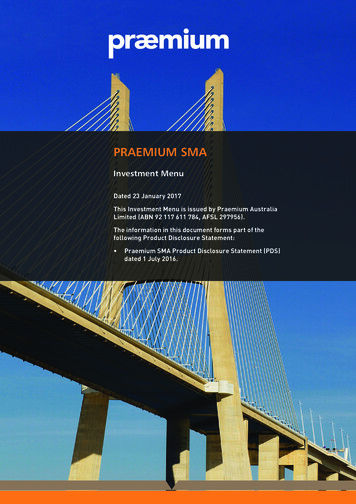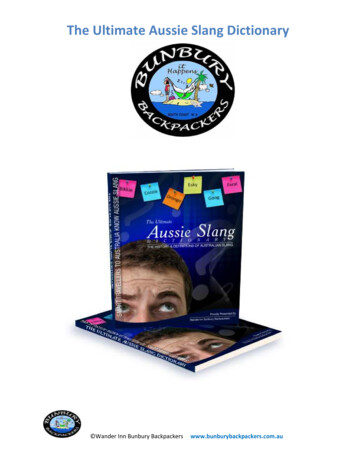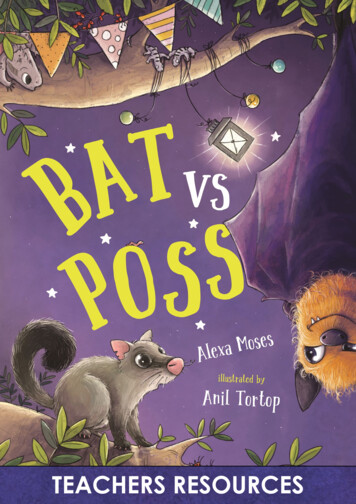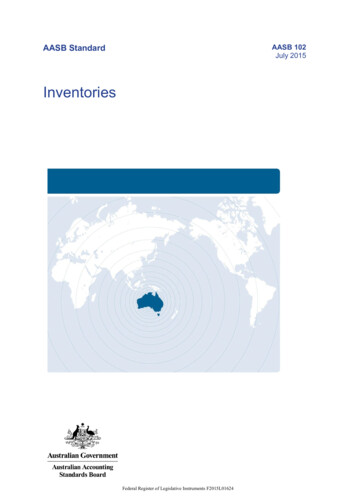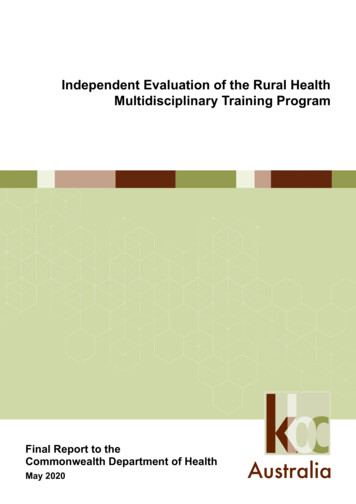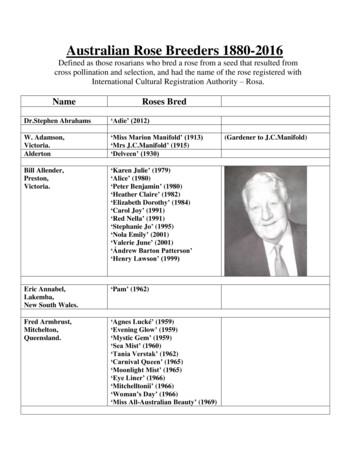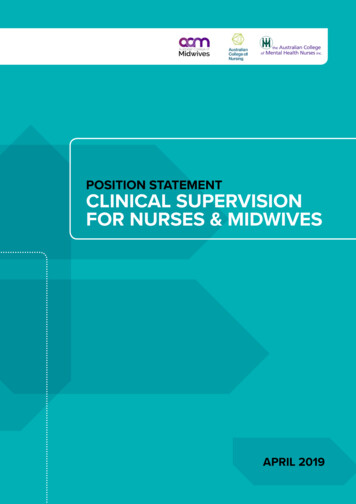
Transcription
THE AUSTRALIAN EDUCATION SYSTEM – FOUNDATION LEVELCONTENTSAcronyms . 31Introduction . 42How the Australian Education System is structured . 53Australian, State and Territory Government responsibilities . 74Early childhood and compulsory school education . 95Vocational education and training . 126Higher education . 127Teacher workforce . 148International comparisons . 149Australian education: key policy initiatives . 161OTest your knowledge . 19References and links . 232
THE AUSTRALIAN EDUCATION SYSTEM – FOUNDATION LEVELACRONYMSABSAustralian Bureau of StatisticsACARAAustralian Curriculum Assessment and Reporting AuthorityACECQAAustralian Children’s Education and Care Quality AgencyACERAustralian Council for Educational ResearchAISCAustralian Industry and Skills CommitteeAITSLAustralian Institute for Teaching and School LeadershipAQFAustralian Qualifications FrameworkAQFCAustralian Qualifications Framework CouncilASQAAustralian Skills Quality AuthorityATARAustralian Tertiary Admission RankCOAGCouncil of Australian GovernmentsCRICOSCommonwealth Register of Institutions and Courses for Overseas StudentsDETDepartment of Education (Australian Government)DFATDepartment of Foreign Affairs and Trade (Australian Government)DPMCDepartment of the Prime Minister and Cabinet (Australian Government)ESOSEducation Services for Overseas StudentsFTAfree trade agreementGDPGross Domestic ProductHECS-HELPHigher Education Loans ProgramNAPLANNational Assessment Program-Literacy And NumeracyNCVERNational Centre for Vocational Educational ResearchOECDOrganisation for Economic Cooperation and DevelopmentPISAProgramme for International Student AssessmentQILTQuality Indicators for Learning and TeachingRTOregistered training organisationSRSSchooling Resource StandardTACTertiary Admission CentreTAFETechnical and Further EducationTEQSATertiary Education Quality Standards AgencyTIMSSTrends in International Mathematics and Science StudyUKUnited KingdomUNESCOUnited Nations Educational, Scientific and Cultural OrganizationUSUnited States of AmericaVETvocational education and trainingWGEAWorkplace Gender Equality Agency3
THE AUSTRALIAN EDUCATION SYSTEM – FOUNDATION LEVEL1 INTRODUCTIONThe purpose of this module is to provide an overview of the Australian education system. Itprovides a foundation to engage in this topic and apply advice from staff with operational orexpert levels of knowledge in education. On successful completion you will be able to be aninformed participant in multi-stakeholder forums related to Australian education.The importance of Australian education to Australia’s economyThe contribution of international education to the Australian economy is significant. The mostrecent figures from the Australian Bureau of Statistics (ABS) show that international education isvalued at 19.9 billion, making it Australia’s third largest export. In addition, it is estimated that130,000 of the international students in Australia in 2014-15 will contribute as skilled migrants inthe Australian workforce on graduation, representing a 3 per cent increase in the proportion ofAustralia’s current workforce with a tertiary education.Australian education is a dynamic and growing service market. In 2016, Australia ranked as thethird largest provider of education to international students after the United States (US) and theUnited Kingdom (UK).Currently around five million tertiary students study outside their own country. The United NationsEducational, Scientific and Cultural Organization (UNESCO) estimates this number will increase toeight million by 2025.The ABS estimates international education to be worth a record 21.8 billion in 2016 – up 17 percent on 2015. The ABS also estimates the sector contributes over 130,000 jobs to the Australianeconomy. Additionally, it is estimated that more than 130,000 students are studying an Australianqualification offshore, an area of the sector which is valued at more than 400 million per annum.The Australian Government’s National Strategy for International Education 2025 (the NationalStrategy) released in 2016 tional-Strategy.aspx), recognises theimportance of our largest services export to our future economic prosperity. It also highlights theimportance of maintaining the quality of Australian education institutions and of the internationalstudent experience, particularly in relation to employability, to continue growth in the sector. TheNational Strategy also speaks to the vital soft-power importance of international educationcultivated through two-way mobility programs for both students and researchers and the role ofqualifications recognition in facilitating global workforce mobility.The National Strategy is framed around three key policy pillars: strengthening the fundamentals of our education system to deliver a high quality, worldclass education and student experience making transformative partnerships both at home and abroad through mobility initiativesand alumni connections and competing globally by promoting our excellence in education services and growing theopportunities to expand our international education markets.Sources: Department of Education and Training (DET) 2016d, Export income to Australia from internationaleducation activity in 2015-16, found at 16.pdfAustralian Bureau of Statistics (ABS) 2016, International trade: Supplementary information, financial year, 2015-16,cat. No. 5368.0.55.003, found at 55.0034
THE AUSTRALIAN EDUCATION SYSTEM – FOUNDATION LEVELA comparatively privatised education systemThe Australian education system is distinctive in that it is highly privatised in both the school andhigher education sectors compared with the systems in other countries. In terms of studentenrolment, in 2016 34.6 per cent of school student enrolments were in private schools but themajority of higher education enrolments (93 per cent) were in public universities. The AustralianEducation Act (2013; updated 2017) found at is the principal legislation for the provision of funding to schools. The proportion of private (nongovernment funded) investment in Australian schools is much greater than in other Organisationfor Economic Co-operation and Development (OECD) countries (at almost 40 per cent for Australiacompared to the OECD average of 16 per cent). The situation is similar in the higher educationsector.Source: Australian Government 2016, Budget 2016-17: Statement 5: Expenses and net capital investment(continued), 3 May, found at http://budget.gov.au/2016-17/content/bp1/html/bp1 bs5-01.htmRobust regulatory frameworkA great strength of the Australian education system is its robust regulatory framework andtransparent accountability mechanisms. There are three main regulatory bodies relating toeducation: the Tertiary Education Quality and Standards Agency (TEQSA), the Australian SkillsQuality Authority (ASQA); and the Australian Children’s Education and Care Quality Authority(ACECQA).2 HOW THE AUSTRALIAN EDUCATIONSYSTEM IS STRUCTUREDFour sub-sectorsThe Australian education system is broadly structured as follows:1 primary school: seven or eight years, starting at Foundation (also calledkindergarten/preparatory/pre-school) through to Year 6 or 72 secondary school: four years from Years 7 or 8 to 103 senior secondary school: two years from Years 11 to 124 tertiary education: includes higher education and vocational education and training(VET).The Australian Qualifications Framework (AQF) is a national framework which coversqualifications in post-compulsory education. It has 10 levels and links school, vocational andhigher education qualifications into a single national system, allowing easy movement from onelevel of study to another and between institutions. More about the AQF can be found athttp://www.aqf.edu.au/The study options that students can take as they progress through the formal education systemare flexible, but generally the broad pathways taken are shown in the diagram below.5
THE AUSTRALIAN EDUCATION SYSTEM – FOUNDATION LEVELAustralian education system at a glance*Graduate Certificates and Graduate Diplomas are also awarded by registered trainingorganisations (RTOs) as VET qualificationsSource: DET 2015, Country education profiles: Australia, found ED15-0091 INT Australia Country Education Profile 2015 ACC.pdf6
THE AUSTRALIAN EDUCATION SYSTEM – FOUNDATION LEVEL3 AUSTRALIAN, STATE AND TERRITORYGOVERNMENT RESPONSIBILITIESA shared responsibilityEducation and training is a shared responsibility of the Australian (Federal) Government and theindividual State and Territory Governments.The Australian Government, primarily through the Department of Education and Training (DET),provides: funding and regulation support to early childhood education and care centres such as preschools and kindergartens partial funding of government schools and majority funding for non-government schools supplementary funding for VET partial funding for the operation of public universities through grants, scholarships andspecial purposes such as for teaching and research programs international education, under the Education Services for Overseas Students (ESOS) Act 2000(updated December 2015) and the Commonwealth Register of Institutions and Courses forOverseas Students (CRICOS). Updates to the ESOS Act can be found Recent-changes.aspxThe Australian Government’s key education forums,organisations, agreements and programsUnder the Commonwealth Constitution, education in Australia is primarily the responsibility ofthe State and Territory Governments. They are largely responsible for the funding of governmentschools. State and Territory Governments regulate the public and private (including faith-based)schools within their States/ Territories, oversee course accreditation, student assessment andawards for both government and non-government schools and early childhood learning centres.Responsibilities for child care and pre-school are also shared between the Australian, State andTerritory Governments, as follows: the Australian Government has policy responsibility for formal care (long day care, family daycare, outside school hours care, and some occasional care) the Australian Government administers fee subsidies for child care and provides somefunding to Australian Government approved services for specific purposes. Regularly updatedinformation can be found at https://www.education.gov.au/child-care-subsidy-0 the Australian Government oversees quality accreditation systems in early childhood educationand care the Australian Government supports specialised pre-school for Indigenous Australians State and Territory Governments are responsible for the policy and funding of pre-schools.Pre-school education is delivered using a variety of funding and delivery models, includingprivate provision7
THE AUSTRALIAN EDUCATION SYSTEM – FOUNDATION LEVEL State and Territory Governments are responsible for some occasional care centres. SomeState and Territory Governments contribute financially to outside school hours care, long daycare and other such services.Source: Productivity Commission 2016, ‘Overview B Child care, education and training, attachment tables and dataquality information’, in Report on government services 2016, volume B, section B.1, found rainingPrimary and secondary schools in Australia are either government or privately funded.The Australian Government is responsible for: allocating funding to States and Territories to support service delivery and reform to meetnationally agreed outcomes ensuring that the funding arrangements for the non-government school sector and schoolsare consistent with, and support the responsibilities of the States and Territories inregulation, educational quality, performance and reporting on educational outcomes leading Australia’s international engagement on educational matters including internationalassessment programs.State and Territory Governments are responsible for infrastructure and maintenance funding, thepayment of teachers, principals and non-teaching staff and the administration and managementof all resources within schools.Source: Council of Australian Governments (COAG) 2013, National Education Reform Agreement, found .au/files/docs/national-education-reform-agreement 0.pdfState and Territory Governments are responsible for the administration and major funding of VETand for legislation relating to the establishment and accreditation of higher education courses.Each State has a VET system, consisting of government-funded Technical and Further Education(TAFE) institutes and private registered training organisations (RTOs). VET qualifications aretransferable between all States and Territories. Study undertaken in one State/Territory gains thesame status in another.Significant organisations and agreements focused on improving school education at a nationallevel include: the Council of Australian Governmentsthe Department of Education and Trainingthe Australian Institute for Teaching and School LeadershipNational Partnership Agreements.These entities are briefly outlined on the following pages.The Council of Australian GovernmentsThe Council of Australian Governments (COAG) has representation from State and TerritoryGovernments and sets key policy directions to be adopted nationally. COAG’s Education Councilis one of eight Councils responsible to COAG through their Chair. The COAG Education Councilprovides a forum through which strategic policy on school education, early childhood and highereducation can be coordinated at the national level and through which information can be shared,and resources used collaboratively, to address issues of national significance.The above and further information about COAG’s Education Council can be found at http://www.educationcouncil.edu.au/. Their 2014 Terms of Reference can be found rms-of-Reference.aspx8
THE AUSTRALIAN EDUCATION SYSTEM – FOUNDATION LEVELThe Department of Education and Training (DET)The key Australian Government agency responsible for national education policies and programsis the Department of Education and Training (DET) whose responsibilities include: early childhoodschoolinghigher educationhigher education teaching and researchvocational education and training (VET)International Education.DET delivers the Australian Government’s priorities and goals through the development andimplementation of education policies and programs. The goals are achieved in conjunction withthe State, Territory and regional networks, and through engagement with non-governmentstakeholders.The above and further information about DET can be found at its websitehttps://www.education.gov.au/The Australian Institute for Teaching and School LeadershipThe Australian Institute for Teaching and School Leadership (AITSL) provides national leadershipfor the Australian, State and Territory Governments in promoting excellence in the profession ofteaching and school leadership. AITSL provides leadership in the accreditation of Initial TeacherEducation programs and the promotion and embedding of the Australian Professional Standardsfor Teachers and Principals.The National Education AgreementUnder the National Education Agreement (2014), all the respective Australian Governments haveagreed to work together toward the objective that Australian schooling provides a high qualityand equitable education for all.4 EARLY CHILDHOOD AND COMPULSORYSCHOOL EDUCATIONEarly childhood educationThe role of early childhood education is to provide care and supervision of children, to preparechildren for school, and to ensure that children are able to effectively participate in subsequentlearning opportunities. Early childhood education programs are conducted in communityprograms, pre-schools and other child-care settings.Australia’s participation rates at age four have risen markedly since 2005 (from 53 per cent in2005 to 89 per cent in 2016) representing the fourth highest increase in the OECD.Source: OECD 2016d, Starting Strong IV: Early Childhood Education and Care Data Country Note: Australia, found .pdf9
THE AUSTRALIAN EDUCATION SYSTEM – FOUNDATION LEVELPrimary and secondary schoolsThere were 9,414 schools in Australia in 2016 with approximately 3,798,226 students.Source: ABS 2017a, Schools, Australia, 2016, found 221.0Main Features12016?OpenDocumentIt is compulsory for children to have commenced school by the time they have turned six years ofage. Most children start between four-and-a-half and five-and-a-half years. Children generallyattend primary school until they are 11 or 12 years of age. Primary schools offer programs fromFoundation to Years 6 or 7.Since 2010, it has been mandatory in all States and Territories for students to complete Year 10and participate full time in education, training or employment, until they are at least 17 years old.Primary schools focus on developing essential literacy, numeracy and social skills, and providefoundational knowledge to children about the world around them.In some jurisdictions middle schools have been introduced. Middle schools offer programs forstudents in Years 7 to 10 (although this varies from school to school). On leaving middle schools,students often attend high schools or colleges to complete the Years 10, 11 and 12.In jurisdictions where there are only primary and secondary schools, students between the agesof 13 and 18 years attend high schools or secondary schools. Progressively, as students movefrom primary into secondary schools, subject matter becomes increasingly specialised.Students who complete their secondary school program at Year 12 or equivalent are awarded aSenior Secondary Certificate of Education. They then leave school to undertake vocational orhigher education courses and/or start work. The secondary retention rate in Australia in 2016(i.e. the number of school students who commenced Year 7/8 and completed Year 12, expressedas a percentage) was 80.9 per cent for male students and 87.8 per cent for female students.Source: ABS 2017a, Schools, Australia, 2016, found 221.0Main Features12016?OpenDocumentMore information about Australian school structures can be found in the Australian Curriculum,Assessment and Reporting Authority (ACARA) National Report on Schooling in Australia, found rt-on-schooling-in-australia-2013Government and non-government schoolsIn 2016, the number of students enrolled in Australian primary and secondary schools grew by47,253 (1.3 per cent) compared with 2015 to a total of 3,798,226. In 2016, the proportion ofstudents enrolled in government schools increased from 65.2 per cent in 2015 to 65.4 per cent.The proportion of students enrolled in Catholic schools fell by 0.2 per cent over the same period.Enrolment in Independent schools remained at 14.4 per cent.Source: ABS 2017a, Schools, Australia, 2016, found 221.0Main Features12016?OpenDocumentRegular updated data on education can be found at the ABS website available at:http://www.abs.gov.au/educationMore information regarding Australia’s performance in primary and secondary schools can befound at the OECD website available at: http://www.oecd.org/education/school/10
THE AUSTRALIAN EDUCATION SYSTEM – FOUNDATION LEVELEnglish as the official languageEnglish is the official language of Australia and the main language of instruction. Some schoolsoffer bilingual programs or programs in other languages.Academic yearThe Australian academic year begins in late January or early February for school students, andruns to mid-December. Most schools have three or four terms a year. Some jurisdictions haveflexibility about the school year to allow for specific community contexts. In northern Australia,for example, the school year begins in January, and the tuition times are structured to allow afour-week break in the middle of the year, when the weather is drier and cooler.Students from other countriesThere were 554,179 international students of 192 nationalities studying in Australia in 2016.Approximately 43 per cent of international student enrolments were at the higher educationlevel.Source: DET 2016c, End of year summary of international student enrolment data-Australia-2016, found RIES/2016/12 December 2016 FullYearAnalysis.pdfNational Curriculum and assessmentAustralia has a National Curriculum for schools which has been progressively developed by theAustralian Curriculum, Assessment and Reporting Authority (ACARA). ACARA was establishedunder Section 5 of the Australian Curriculum, Assessment and Reporting Authority Act (Cth) on8 December 2008. ACARA’s functions include development of National Curriculum, administrationof national assessments and associated reporting on schooling in Australia. ACARA’s strategicdirections are set by its Charter and any other written instructions from the COAG EducationCouncil. Their work includes the introduction of curriculum frameworks and learning outcomesthat are to be common across all schools, from Foundation (i.e. Kindergarten) to Year 12. Roll-outof the national standardised Australian Curriculum began in 2012.Source: Australian Curriculum, Assessment and Reporting Authority (ACARA) website, found athttp://www.acara.edu.auThe National Assessment Program – Literacy and Numeracy (NAPLAN) is an annual assessmentfor students in Years 3, 5, 7 and 9. NAPLAN tests the sorts of skills that are essential for every child to progress through schooland life, such as reading, writing, spelling and numeracy. The assessments are undertakennationwide, every year, in the second week in May NAPLAN comprises tests in four areas (or ‘domains’):1 Reading2 Writing3 Language Conventions (spelling, grammar and punctuation)4 Numeracy NAPLAN tests skills consistent with the school curriculum The 2016 NAPLAN results showed that almost 94 per cent of children have met nationalminimum standards for their age/stage.Source: ACARA 2016b, NAP: National Assessment Program, found at http://www.nap.edu.au/11
THE AUSTRALIAN EDUCATION SYSTEM – FOUNDATION LEVEL5 VOCATIONAL EDUCATION ANDTRAININGThe primary goal of VET is to provide students with the practical skills and experiences to performtasks effectively and safely across a wide range of employment fields. Courses are provided bygovernment-funded TAFE institutes, adult and community education centres and private RTOs.VET can begin in secondary school and many VET institutions have formal pathwaysarrangements with universities whereby VET students have assured entry into university onsuccessful completion of their VET qualification. Some institutions, such as Victoria University,identify as ‘dual-sector’ offering both higher education and VET. Just as in the school and highereducation sectors, there is a blend of private and public organisations providing VET programs inall States and Territories. There were approximately 4.5 million students enrolled in VET coursesin Australia in 2015.Source: National Centre for Vocational Education Research (NCVER) website, found at https://www.ncver.edu.au/6 HIGHER EDUCATIONHigher education requires intensive study over a number of years to achieve a recognised highlevel qualification. The Australian higher education sector offers a wide diversity of programs thatlead to highly regarded and internationally recognised qualifications. There are 43 universities inAustralia, of which two are international universities and one is a private specialty university.About one-quarter of students enrolled in Australian universities come from overseas. A list ofthese universities is available on the National Register at the TEQSA website found athttp://www.teqsa.gov.au/national-registerThe Australian Government provides public funding to the higher education sector through theHigher Education Support Act, 2003 (amendments can be found 03).The Government provides funding touniversities to contribute to the costs associated with each domestic student enrolled.In 2015, 1,410,133 domestic and international students were enrolled in Australian universityprograms.Source: DET 2016g, Summary of the 2015 full year higher education student statistics, found dent-summaryPublic universities are established or recognised under State and Territory legislation. TEQSA isthe national independent regulator for the higher education sector. TEQSA registers and assessesthe performance of higher education providers against the Higher Education StandardsFramework, and undertakes both compliance and quality assessments of providers. It does thismainly through registration/re-registration processes and through course accreditation/reaccreditation processes for providers without self-accrediting authority.Source: Tertiary Education Quality and Standards Agency (TEQSA) website, found at http://www.teqsa.gov.au/For further information, see the Higher Education modules.A significant feature of the tertiary education landscape in Australia is the large proportion ofinternational students, representing approximately 25 per cent of all students enrolled atAustralian universities. Australia is a key destination for students from around the world, hosting12
THE AUSTRALIAN EDUCATION SYSTEM – FOUNDATION LEVELmore than 8.5 per cent of the world’s overseas students. International education contributed 19.9 billion to Australia’s Gross Domestic Product (GDP) in 2015-16.In order for international students to receive a visa to study in Australia they must be offeredadmission to study a program at an institution on the Commonwealth Register of Institutions andCourses for Overseas Students (CRICOS).Most international students enrolled in Australia are from the Asia region. Significant differencesoccur, however, across sub-sectors. For example, the majority of Chinese students are enrolled inhigher education while Indian students are predominantly enrolled in VET.Source: DET 2016e, International student data 2016, found ntData2016.aspxFor further details, please see the Practitioner Level Module.Undergraduate admission pathwaysAdmission to an undergraduate degree is usually based on a student’s Australian TertiaryAdmission Rank (ATAR). The ATAR is calculated by a State or Territory Tertiary Admission Centre(TAC) based on a Senior Secondary Certificate of Education (Year 12 Award) or InternationalBaccalaureate. The ATAR is used in all States and Territories except Queensland (where anOverall Position is calculated).Other undergraduate admission pathways include: a VET qualification, such as a Certificate III or IV additional requirements such as an interview, portfolio of work, prerequisite courses, and/ora demonstrated interest or aptitude for the study program mature age entry for students over 25 years based on related work experience, an entranceexamination, or a demonstrated aptitude for study.Source: DET 2015, Country education profiles: Australia, found ED15-0091 INT Australia Country Education Profile 2015 ACC.pdfAcademic yearFor VET students, the Australian academic year begins in late February/early March. Vocationalinstitutes and higher education institutions usually have two semesters with exams orassessments held in June and November. The long summer holiday break is from November toFebruary. Some higher education institutions have introduced a third 'semester' that runs in thesummer months.Lifelong learningThe Australian education system has a commitment to lifelong learning – that is, learning that isundertaken at all stages of life. In the 12 months to April 2013 (latest available data), forexample, it was estimated that of the
The ABS estimates international education to be worth a record 21.8 billion in 2016 - up 17 per cent on 2015. The ABS also estimates the sector contributes over 130,000 jobs to the Australian economy. Additionally, it is estimated that more than 130,000 students are studying an Australian



